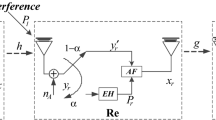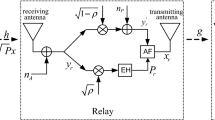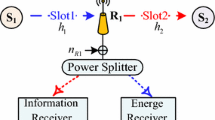Abstract
This paper investigates the relay energy allocation scheme based on the time switching (TS) operation strategy in multi-user simultaneous wireless information and power transfer (SWIPT) relaying system, where the relay is energy-constrained and utilizes the energy harvested in the energy harvesting mode to amplify and forward the information of the users. In the multi-user relaying system, the distances of the receivers of the users to the relay may be different. Thus, the total information rate maximization model is proposed and the corresponding energy allocation scheme is derived. After comparing the information rates of users, it is found that the information rates of users who are far from the relay are significantly lower than those of users who are close to the relay, i.e., “far-near” phenomenon. For the “far-near” problem, we propose the common information rate maximization model, and derive the corresponding energy allocation scheme. In this model, the information rates of all users are equal, which ensures the fairness of the information rate in multi-user relaying communication system. The simulation results show that the energy allocation scheme based on the common information rate maximization model can effectively solve the “far-near” problem in multi-user relaying communication system.








Similar content being viewed by others
References
Visser HJ, Vullers RJM (2013) RF energy harvesting and transport for wireless sensor network applications: principles and requirements. Proc IEEE 101(6):1410–1423
Nishimoto, H., Kawahara, Y., Asami, T. (2010) Prototype implementation of ambient RF energy harvesting wireless sensor networks. 2010 IEEE Sensors Conference, pp. 1282–1287
Zhang X, Jiang H, Zhang L, Zhang C, Wang Z, Chen X (2010) An energy-efficient ASIC for wireless body sensor networks in medical applications. IEEE Transactions on Biomedical Circuits and Systems 4(1):11–18
Lu X, Niyato D, Wang P, Kim D, Han Z (2015) Wireless charger networking for mobile devices: fundamentals, standards, and applications. IEEE Wirel Commun 22(2):126–135
Varshney, L. R. (2008) Transporting information and energy simultaneously. 2008 IEEE International Symposium on Information Theory, pp. 1612–1616
Lu X, Wang P, Niyato D, Kim D, Han Z (2015) Wireless networks with RF energy harvesting: a contemporary survey. IEEE Communications Surveys & Tutorials 17(2):757–789
Zhang R, Ho CK (2013) MIMO broadcasting for simultaneous wireless information and power transfer. IEEE Trans Wirel Commun 12(5):1989–2001
Liu L, Zhang R, Chua KC (2013) Wireless information transfer with opportunistic energy harvesting. IEEE Trans Wirel Commun 12(1):288–300
Zhou X, Zhang R, Ho CK (2013) Wireless information and power transfer: architecture design and rate-energy tradeoff. IEEE Trans Commun 61(11):4754–4767
Han S, Zhang Y, Meng W, Chen H (2018) Self-interference-cancelation-based SLNR Precoding design for full-duplex relay- assisted system. IEEE Trans Veh Technol 67(9):8249–8262
Peng C, Li F, Liu H (2017) Optimal power splitting in two-way decode-and-forward relay networks. IEEE Commun Lett 21(9):2009–2012
Zhong S, Huang H, Li R (2018) Outage probability of power splitting SWIPT two-way relay networks in Nakagami-m fading. EURASIP J Wirel Commun Netw 1:11
Li, D., Shen, C., Qiu, Z. (2013) Sum rate maximization and energy harvesting for two-way of relay systems with imperfect CSI. 2013 IEEE International Conference on Acoustics, Speech and Signal Processing, pp. 4958–4962
Li Q, Zhang Q, Qin J (2014) Secure relay beamforming for simultaneous wireless information and power transfer in nonregenerative relay networks. IEEE Trans Veh Technol 63(5):2462–2467
Krikidis I, Timotheou S, Sasaki S (2012) RF energy transfer for cooperative networks: data relaying or energy harvesting? IEEE Commun Lett 16(11):1772–1775
Krikidis I, Sasaki S, Timotheou S, Ding Z (2014) A low complexity antenna switching for joint wireless information and energy transfer in MIMO relay channels. IEEE Trans Commun 62(5):1577–1587
Assanovich, B. A. (2008) Two schemes for block-based transmission of variable-length codes. 2008 IEEE Region 8 International Conference on Computational Technologies in Electrical and Electronics Engineering, pp. 253–256
Acknowledgments
This work was supported by the National Natural Science Foundation of China (Grant No. 51877151, 61372011), and Program for Innovative Research Team in University of Tianjin (Grant No. TD13-5040).
Author information
Authors and Affiliations
Corresponding author
Additional information
Publisher’s note
Springer Nature remains neutral with regard to jurisdictional claims in published maps and institutional affiliations.
Appendices
Appendix 1
Notation: f1(x)|x represents the derivative of f(x) with respect tox; f2(x)|x denotes the derivative of f1(x)|x with respect tox
In (11), taking the first and second derivatives of Ri(τ) with respect toτi, we obtain
The Hessian matrix of Ri(τ) is defined as
where \( {d}_{j,j}^{(i)} \) represents the entry for row j, column j of∇2Ri(τ), and
For any real vectorv = [v1, ⋯vK]T, we have
i.e., ∇2Ri(τ)is a negative semidefinite matrix for any i; therefore, Ri(τ)is a convex function ofτ = [τ1, ⋯τK].
Appendix 2
The Lagrangian of the problem P1 can be expressed as
where υ represents the lagrangian multiplier. Taking the first derivatives of Lsum(τ, υ) with respect to υ andτi, respectively, we have
Making Lsum(τ, υ)1⃓v = 0 andLsum(τ, υ)1⃓ti = 0, we have
According to (24), we obtain
According to (25), we obtain
So, we have
According to\( \frac{\gamma_1}{1+{\gamma}_1\cdotp {\tau}_1}=\frac{\gamma_2}{1+{\gamma}_2\cdotp {\tau}_2} \), we have
Similarly, we can obtain
Combined with\( {\sum}_{i=1}^K{\tau}_i=1 \), we obtain
Further, we have
So, we have
By substituting (33) into (29), we obtain
Similarly, we have
Rights and permissions
About this article
Cite this article
Li, X., Ding, X., Li, K. et al. Relaying Energy Allocation Scheme Based on Multi-User SWIPT Relaying System. Mobile Netw Appl 25, 1663–1672 (2020). https://doi.org/10.1007/s11036-020-01576-6
Published:
Issue Date:
DOI: https://doi.org/10.1007/s11036-020-01576-6




